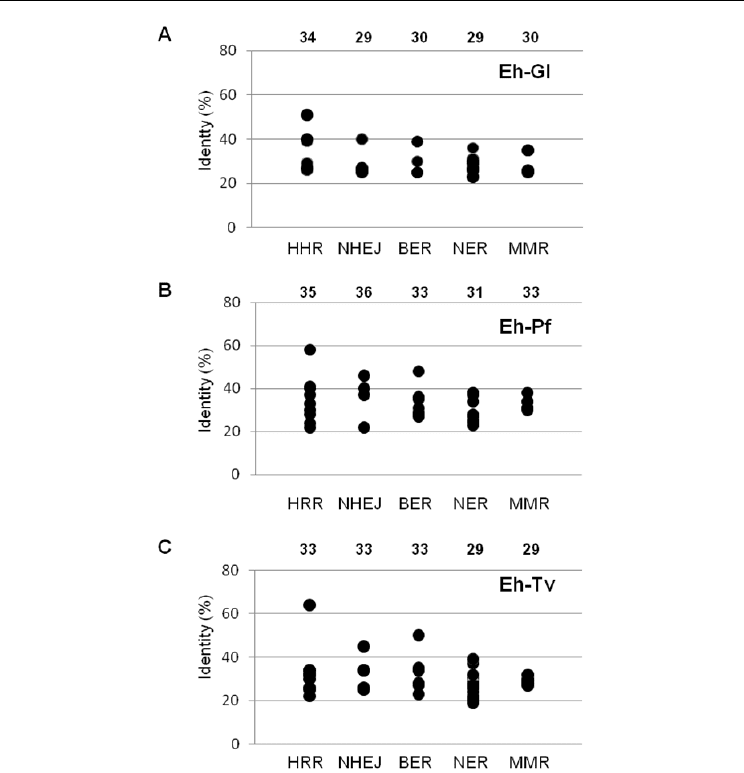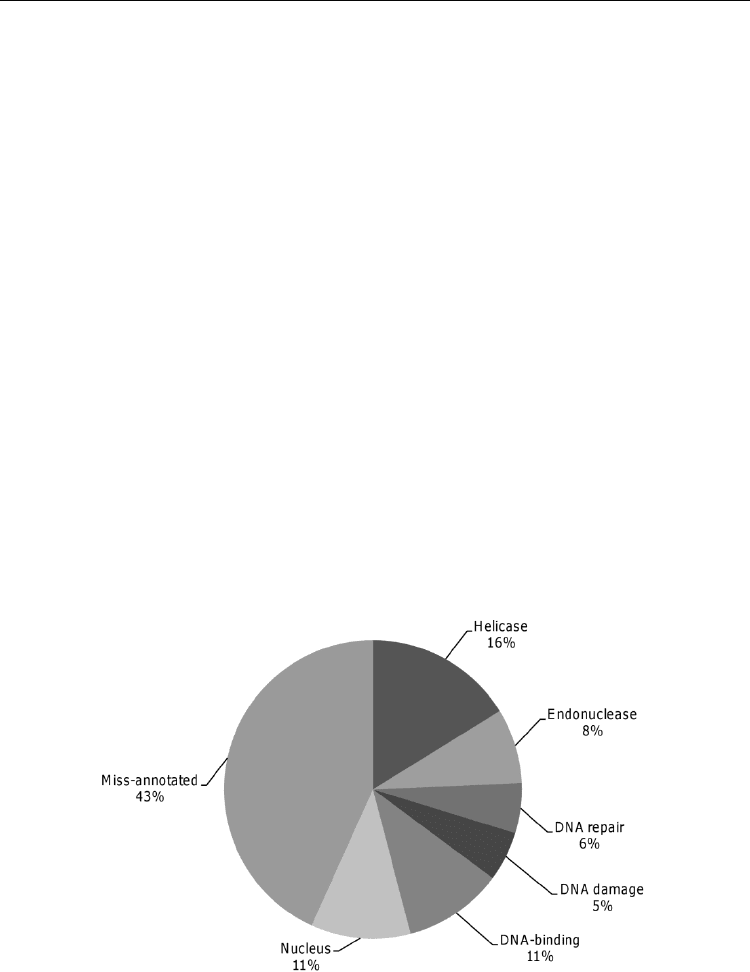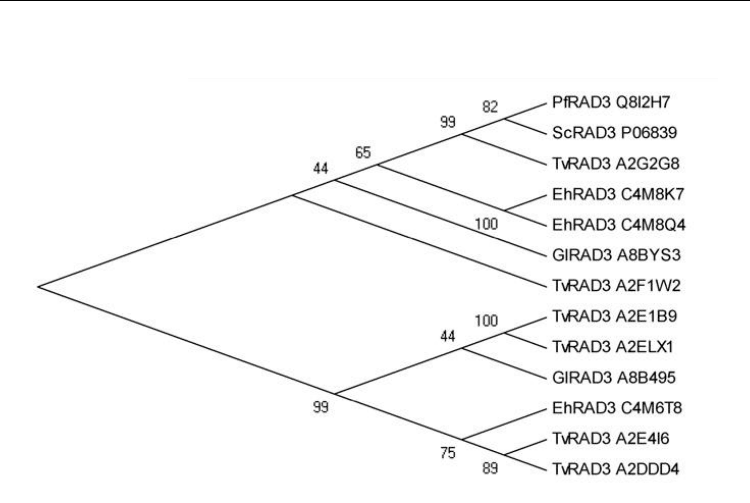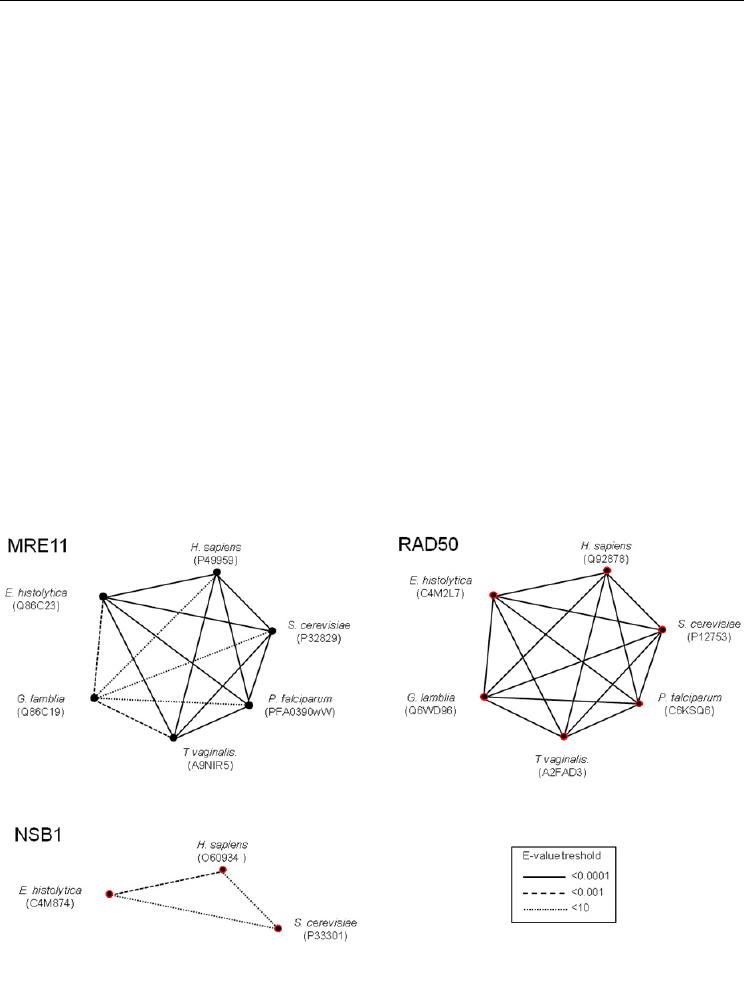Chen C.C. (ed.) Selected Topics in DNA Repair
Подождите немного. Документ загружается.


DNA Repair in Pathogenic Eukaryotic Cells:
Insights from Comparative Genomics of Parasitic Protozoan
371
P. falciparum and T. vaginalis (Table 1). The absence of a given sequence in the table indicates
that the corresponding gene was not identified in the parasite genome or that the sequence
was too divergent to be detected by our in silico strategy.
None of the protozoan parasites studied here has the complete DNA repair pathways reported
in yeast. HRR is the most conserved pathway suggesting that it is the mayor DSB repair
pathway in these protozoan parasites. E. histolytica, G. lamblia, P. falciparum and T. vaginalis
genomes contain most of the RAD52 epistasis group genes, although their functional relevance
remains to be determined. Homologs for RAD50, RAD51, MRE11, RAD54 and RPA (lacking
the RAD52 interacting domain) have been previously reported in P. falciparum [Voss et al.,
2002; Malik et al., 2008]. In agreement with its participation in DNA repair, the PfRad51 gene is
overexpressed in the mitotically active schizont stage and in response to methyl methane
sulfonate [Bhattacharyya & Kumar, 2003]. In. T. vaginalis, RAD50 y MRE11 were previously
published as components of the meiotic recombination machinery, although meiosis has not
been observed in this organism [Malik et al., 2008]. Ramesh et al. [2005] and Malik et al. [2008]
identified the Rad50/Mre11, Rad52 and Dmc1 genes involved in meiotic recombination
machinery by HRR in Giardia. Intriguingly, G. lamblia and P. falciparum lack the nsb1
homologue (xrs2 in Yeast) that is a component of the MRN complex involved in DSB detection
and 3´ ssDNA tails conversion. Recently, we published the E. histolytica RAD52 epistasis group
involved in HRR [Lopez-Casamichana et al., 2007, 2008]. Interestingly, RT-PCR assays
evidenced that some genes were down-regulated, whereas others were up-regulated when
DSB were induced by UV-C irradiation, which revealed an intricate transcriptional
modulation of E. histolytica RAD52 epistasis group related genes in response to DNA damage.
Particularly, Ehrad51 mRNA expression was 16-, 11- and 4-fold increased at 30 min, 3 h and 12
h, respectively. DNA microarrays assays confirmed the activation of EhMre11, EhRad50, and
EhRad54 genes at 5 min after DSB induction, suggesting that they represent early sensors of
damage in HRR pathway [Weber et al., 2009]. Additionally, the molecular characterization of
EhRAD51 showed that the presence of all the functional domains reported in yeast and human
homologues. EhRAD51 was upregulated and redistributed from cytoplasm to the nucleus of
trophozoites at 3 h after DNA damage and it was able to catalyze specific single-strand DNA
(ssDNA) transfer to homologous double strand DNA (dsDNA) forming the three-stranded
pairing molecule called D-loop structure, confirming that it is a bonafide recombinase in E.
histolytica [Lopez-Casamichana et al., 2008].
G. lamblia and P. falciparum
only have three of the eight factors of the NHEJ pathway
(including the MNR complex also involved in HRR), which strongly suggest that they
preferably use HRR to repair DSB. In contrast, almost all NEHJ pathway factors have been
identified in E. histolytica and T. vaginalis, including the LIF1 ligase, RAD27 nuclease and
MRE11/RAD50/NSB1 proteins. However, E. histolytica genome does not contain a
homologous gene for KU80 subunit [López-Camarillo et al., 2009] and T. vaginalis lacks both
ku70 and ku80 genes [Carlton et al., 2007]. As these proteins form a single KU complex that
recognizes DSB sites and recruits other DNA repair factors, our findings could appear
contradictory. The absence of conserved KU proteins has also been reported in Encephalitozoon
cunili [Gill & Fast, 2007] and yeast [Hefferin & Tomkinson, 2005], thus it is possible that these
organisms use highly divergent KU proteins to perform the NHEJ pathway.
The other key DNA repair mechanisms represented by BER, NER and MMR pathways
operate to repair aberrant bases or nucleotides from a ssDNA using the complementary
strand as template for DNA synthesis. As in E. histolytica [Lopez-Camarillo et al., 2009], the
G. lamblia BER pathway appears to be largely incomplete, lacking apn1, mag1, ogg1, rad10,
mus81 and mms4 genes. Both parasites live under oxygen-limiting conditions and have a

Selected Topics in DNA Repair
372
highly reduced form of mitocondria called mitosomes [Tovar et al., 1999, 2003]. Then the
absence of OGG1 could indicate that they do not suffer oxidative damage to mitochondrial
DNA. In contrast, Plasmodium Flap endonuclease-1 (PfFEN-1) and Pf DNA Ligase I (PfLigI)
have enzymatic activities similar to other species [Gardner et al., 2002; Casta et al., 2008],
indicating that BER pathway should be functional in this parasite although several
components are lacking.
Most genes involved in NER pathway are represented in E. histolytica [Lopez-Camarillo et
al., 2009], G. lamblia, P. falciparum and T. vaginalis genomes suggesting that this mechanism
could be potentially active in these eukaryotic parasites. PfXPB/RAD25, PfXPG/RAD2 and
PfXPD/RAD3 have been previously reported in P. falciparum [Gardner et al., 2002; Bethke et
al., 2007; Casta et al., 2008]. Additionally, the overexpression of EhDdb1, EhRad23 and
EhRad54 genes after UV-induced DNA damage in E. histolytica [Weber et al., 2009] suggested
that these genes could be involved in chromatin remodeling complexes as their homologues
in human and yeast. E. histolytica, G. lamblia and T. vaginalis have various rad3 genes to form
the NEF3 complex (RAD2, RAD3, RAD25) of the BER pathway. Particularly, we identified
six rad3 genes and an additional truncated gene in T. vaginalis. On the other hand, all the
parasites studied here lack almost one of the components of the TFIIH complex subunits
(TFB1, TFB2 or TFB3).
As in bacteria, Drosophila melanogaster, H. sapiens and many other organisms [Lisby &
Rothstein, 2005], E. histolytica, G. lamblia [Ramesh et al., 2005], P. falciparum [Bethke et al., 2007]
and T. vaginalis [Malik et al., 2008] have almost all S. cerevisiae MMR genes, including the
components of the MUTS (MSH2/MSH6) heterodimer, which strongly suggest that MMR
could be an active DNA repair pathway in these parasites. Notably, E. histolytica and P.
falciparum have two msh2 genes. However, neither E. histolytica nor P. falciparum present the
msh3 gene that is required for the formation of the MUTS (MSH2/MSH3) heterodimer.
PfMSH2-1, PfMSH2-2, PfMSH6, PfMLH1 and PfPMS1 proteins potentially participating in
MMR have been previously reported in P. falciparum. Inhibition of PfMSH2-2 gene increased
mutation rate and microsatellite polymorphism, indirectly demonstrating its relevance in
MMR and microsatellite slippage prevention. Moreover, antimalarial drug resistance has been
recently related to a defective DNA mismatch repair, mainly in PfMutLα content [Castellini et
al., 2011], which demonstrated the relevance of this mechanism for the parasite biology.
Gene name
E. histolytica G. lamblia P. falciparum T. vaginalis S. cerevisiae
Homologous recombination repair (HRR) pathway
rad50
C4M2L7 Q6WD96 C6KSQ6 A2FAD3 P12753
mre11
Q86C23
C4LVX7
C4M8N7*
Q86CI9
A8BR27*
PFA0390w** A2ECB0 P32829
nbs1
C4M874 - - A2DHF7 P33301
rad51
C4M4K4 Q86C21 Q8IIS8
Pf11_0087**
A2FXT7 P25454
rad52
C4M197 Q6WD95 - - P06778
rad54
rad54b
C4LVM6
C4M7S7
- Q8IAN4 A2FNE0 P32863
rad51c
rad57
C4M5L7 - -
A2GIB8 P38953
P25301

DNA Repair in Pathogenic Eukaryotic Cells:
Insights from Comparative Genomics of Parasitic Protozoan
373
Gene name
E. histolytica G. lamblia P. falciparum T. vaginalis S. cerevisiae
rad59
-
- - - Q12223
exo1
C4MBM5 A8BQ11 Q8IBK1 A2E2N7 P39975
rpa1
C4M8G6 - Q9U0J0
Q8I3A1
A2G5D0 P22336
rpa2
C4LT79 - - - P26754
sgs1
C4M4V5 A8BAJ1
A8B9Y0
Q8I2W7
Q8ILG5
A2DYY2 P35187
rad24
C4M5T7 - - A2D9F4 P32641
hpr5
- - Q8I3W6 A2F783 P12954
rad17
ddc1
mec3
-
-
-
-
-
-
-
-
-
-
A2F0Q2
-
P48581
Q08949
Q02574
Non homologous end joining (NHEJ) pathway
ku80
ku70
C4MBG9
-
-
-
-
-
-
-
P32807
Q04437
lif1
-
- - - P53150
dnl4
C4M5H3 - - A2DFX6 Q08387
rad27
C4M6G8 A8B672
D3KG58
Q7K734
Q8IJW1
A2GNP0 P26793
Base excision repair (BER) pathway
apn1
- - Q9BMG7 - P22936
apn21
- A8BGE2 O97240 - P38207
mag1
- - - - P22134
ogg1
- - Q8I2Y2 - P53397
ntg1
C4M764
C4LYM7
- Q8II68 A2DS55 P31378
ung1
C4LUV5 A8B632 Q8ILU6 A2GFQ7 P12887
pcna
C4M9R9 A8BIU1 P61074
Q7KQJ9
A2DQV2 P15873
rad1
C4LT01 D3KH96 Q8ID22 A2DS24 P06777
rad10
C4LW01 - O96136 A2DBF5 P06838
cdc9
C4M5H3 A8BWV4 Q8IES4 A2DFX6 P04819
mus81
- - - A2FKU9 Q04149
mms4
- - - A2DHF7 P38257
Nucleotide excision repair (NER) pathway
rad2
C4M0V9 - O96154 A2GNP0 P07276
rad3
C4M8K7
C4M8Q4
C4M6T8
A8BYS3
A8B495
Q8I2H7 A2G2G8
A2E4I6
A2F1W2
A2DDD4
A2E1B9
A2ELX1
A2G2G9*
P06839

Selected Topics in DNA Repair
374
Gene name
E. histolytica G. lamblia P. falciparum T. vaginalis S. cerevisiae
rad4
- - - - P14736
rad7
- - - - P06779
rad14
- - - - P28519
rad16
-
A8BL62 Q8I4S6 A2D9P9 P31244
rad23
C4MAR5 D3KF29* Q8IJS8 A2FM19 P32628
rad25
C4MA19 A8BMI7 Q8IJ31 A2DEA8 Q00578
rad26
C4MAR8 A8BK31 - A2EXQ4 P40352
rad28
-
- Q8IJ73 A2DZ24 Q12021
ssl1
C4LV67 A8BA50 Q8IEG6 A2ENQ3 Q04673
tfb1
C4LWV8 - - - P32776
tfb2
C4MIG0 - Q8I4Y8 A2E2N2 Q02939
tfb3
-
D3KH94 Q8I3Y3 - Q03290
tfb4
C4M9E2 A8B6C2 Q8IDG5 A2EYI3 Q12004
Mismatch repair (MMR) pathway
mlh1
C4M5R1 - Q8IIJ0 A2EGR5 P38920
msh2
C4M9J9
B1N4L6
Q6WD97 Q8ILI9
C0H4L8
A2EP54 P25847
msh3
-
- - - P25336
msh6
C4M4T8 A8BC61 Q8I447 A2EA54 Q03834
pms1
C4LW71 A8B4I6 Q8IBJ3 A2G2B4 P14242
Table 1. Comparison of DNA repair machineries from E. histolytica, G. lamblia, P. falciparum,
T. vaginalis and S. cerevisiae. * fragment, ** PlasmoDB database.
2.2 Conservation of DNA repair pathways
To investigate the degree of conservation of DNA repair pathways in protozoan parasites,
we next determined the values of Smith-Waterman identity scores between E. histolytica
proteins and their corresponding orthologues in G. lamblia, P. falciparum and T. vaginalis by
BLAST analysis based in pairwaise sequence alignments and calculated the mean value for
each DNA repair machinery (Fig. 1). Data of the MNR complex which participate in HRR
and NHEJ pathways were included in both mechanisms. DSB repair pathways were
generally more conserved than Excision Repair mechanisms. Considering amino acids
identity, mean values for HRR and NHEJ pathways were higher in E. histolytica/P.
falciparum comparison, suggesting that E. histolytica machinery was closer to P. falciparum
than to G. lamblia and T. vaginalis machineries. The comparison E. histolytica/G. lamblia
evidenced that HRR is highly conserved between both parasites, whereas components of the
other pathways were more divergent. In the case of E. histolytica/P. falciparum comparison,
NHEJ appeared to be more conserved that HRR, while the identity of HRR and NHEJ
factors was very similar in E. histolytica/T. vaginalis. In all the parasites, the RAD51
recombinase is the most conserved protein (51%, 58% and 64% when E. histolytica protein
sequence was compared with G. lamblia, P. faciparum and T. vaginalis orthologues,
respectively), which is consistent with its relevant role in HRR mechanism.

DNA Repair in Pathogenic Eukaryotic Cells:
Insights from Comparative Genomics of Parasitic Protozoan
375
Fig. 1. Conservation of DNA repair pathways between E. histolytica and G. lamblia (A), P.
falciparium (B) and T. vaginalis (C). Amino acids sequences from orthologous proteins were
compared by Blast and the percentage of identity was determined through pair wise
alignment of the most conserved region. Average identity of all pathways is indicated above
each graph.
2.3 DNA repair activity in cell free lysates evidences the functionality of DNA repair
proteins
Although insights about the activity of DNA repair proteins in protozoa have been mainly
obtained from experimental evidence based in heterologous expression and characterization
of recombinant proteins, some reports showed that DNA repair activity could be detected in
whole cell extracts, supporting the notion that DNA repair pathways already operates in
vivo. For instance, Haltiwanger et al., (2000) reported the characterization of an AP

Selected Topics in DNA Repair
376
endonuclease activity in a P. falciparum cell free lysate. Authors provide evidence for the
presence of class II, Mg
2+
–dependent and independent AP endonucleases in the extracts.
Moreover, they detected that Plasmodium AP endonuclease(s) possessed a 3´-
phosphodiesterase activity similar to those described in other class II AP endonucleases
Demple et al., 1986. In a related study, it was reported that a P. falciparum lysate contained
uracil DNA glycosylase, AP endonuclease, DNA polymerase, flap endonuclease, and DNA
ligase activities Haltiwanger et al., 2000. In contrast, DNA repair activities in cell lysates
have not been detected in Entamoeba, Giardia and Trichomonas parasites. These data remark
the utility of cell free lysates to understand DNA repair pathways, and pointed out to the
urgency to investigate endogenous DNA repair activities using whole cell extracts in
parasites where no data is available.
3. Functional categorization of Entamoeba histolytica DNA repair genes
To define the putative functions of E. histolytica DNA repair genes in unrelated DNA repair
processes, we investigated the functional diversity of genomic maintenance pathways using
Gene Ontology (GO) annotations. Functional related gene groups were predicted by the David
bioinformatic resources (http://david.abcc.ncifcrf.gov/gene2gene.jsp), using a functional
classification tool which generates a gene-to-gene similarity matrix based in shared functional
annotation using over 75,000 terms from 14 functional annotation sources, allowing the
classification of highly related genes in functionally related groups. Results from this analysis
revealed that a large number of DNA repair genes were miss-annotated in parasites genome
databases (43%). However, our analysis clearly showed that the majority of these genes seems
to participate in DNA repair related processes. Besides, 57% of genes were predicted to
function in DNA repair related process. 11% of genes participates in DNA damage repair, and
18% and 8% have helicase and endonuclease functions, respectively (Fig. 2).
Fig. 2. Functional categorizations of E. histolytica DNA repair genes. Biological processes
and molecular functions were determined using David software
(http://david.abcc.ncifcrf.gov/gene2gene.jsp). Percentage of genes included in individual
categories is given.

DNA Repair in Pathogenic Eukaryotic Cells:
Insights from Comparative Genomics of Parasitic Protozoan
377
4. Duplicated genes: The case of rad3
Gene duplicates represent for 8-20% of the genes in eukaryotic cells, and the rates of gene
duplication are estimated at between 0.2% and 2% per gene per million years. Gene
duplications are one of the major motors in the evolution of genetic systems and may occur
in homologous recombination, retrotransposition event, or duplication of an entire
chromosome [Zhang, 2003]. Duplicated genes are believed to be a main system for the
establishment of new gene functions generating evolutionary novelty [Long & Langley,
1993; Gilbert et al., 1997].
A detailed examination of Table 1 revealed that several DNA repair genes are duplicated in
protozoan parasites, while there is only one gene in yeast. For example, the HRR machinery
includes two rad51 genes in P. falciparum, two rad54 and mre11 genes in E. histolytica [Lopez-
Casamichana et al., 2008], two rpa1 genes in T. vaginalis, and two sgs1 genes in G. lamblia and P.
falciparum. We also identified two rad27 genes in P. falciparum and G. lamblia NHEJ pathway,
two E. histolylica ntg1 and P. falciparum pcna genes in the BER pathway, as well as two msh2
genes for the MMR pathway in E. histolytica and P. falciparum. But the most duplicated gene
was the rad3 gene from the NER mechanism, since there are three genes in E. histolytica, two in
G. lamblia and six in T. vaginalis, whereas P. falciparum has only one rad3 gene, alike yeast.
Remarkably, gene duplication is evident for many other genes in T. vaginalis and reflexes the
massive gene expansion inside the large genome of this pathogen [Hartl & Wirth, 2006]. In
yeast, the RAD3 protein is involved in mitotic recombination and spontaneous mutagenesis,
becoming essential for cell viability in the absence of DNA injury. Furthermore, this protein
participates in the repair of UV-irradiated DNA via NER, and constitutes a subunit of RNA
polII initiation factor TFIIH [Moriel-Carretero & Aguilera, 2010]. S. cerevisiae RAD3 is related to
the H. sapiens XPD, also known as ERCC2. Defects in human XPD result in a wide range of
diseases, including Xeroderma pigmentosum (XP), Cockayne's syndrome, and
Trichothiodystrophy characterized by a wide spectrum of symptoms ranging from cancer
susceptibility to neurological and developmental defects [Liu et al., 2008].
In order to describe the inferred evolutionary relationships among the most abundant
duplicated gene found through the analysis of DNA repair machineries from the human
pathogens studied here, we have undertaken a phylogenetic analysis of RAD3 helicase
orthologues in S. cerevisiae, E. histolyt
ica, T. vaginalis, G. lamblia and P. falciparum. We
evaluated the minimum evolution of RAD3 proteins through the construction of Neighbor-
Joining phylogenetic tree using the MEGA version 5.05 [Tamura et al., 2011]. The robustness
was established by bootstrapping test, involving 500 replications of the data based on the
criteria of 50% majority-rule consensus (Fig. 3). Two main branches that came from a
common ancestor can be observed. On one branch, T. vaginalis RAD3 parologues are
clustered into two sister proteins pairs (A2E1B9 and A2ELX1, A2E4I6 and A2DDD4), that
have each evolved from the same ancestor. Besides, E. histolytica C4M6T8 is closer to T.
vaginalis A2E4I6 and A2DDD4, than to its own paralogues. The other branch supports T.
vaginalis A2G2G8 that is closely related to yeast and P. falciparum RAD3 proteins that came
off the same node. Interestingly, these two organisms only have one rad3 gene. This branch
also includes E. histolytica C4M8K7 and C4M8Q4 sister proteins pair. Intriguingly, the two
Giardia RAD3 proteins have emerged from different nodes and appeared to be more related
to orthologues from other species than to each other; particularly, the branch supporting
Giardia A8B495 also includes Trichomonas A2E1B9 and A2ELX1, while Giardia A8BYS3 is on
the other branch, isolated from the other proteins, such as Trichomonas A2F1W2, which
suggested that these proteins have evolved early.

Selected Topics in DNA Repair
378
Fig. 3. Phylogenetic relationships between RAD3 from S. cerevisiae, E. histolytica, T.
vaginalis, G. lamblia and P. falciparum. The unrooted tree was created with the MEGA 5.05
program using the Neighbor Joining algorithm based on ClustalW. Numbers above the tree
nodes indicate the percentage of times that the branch was recovered in 500 replications.
5. Molecular organization of the MNR complex
The MRE11–RAD50–NBS1 (MRN) complex is considered to have an imperative function in
DSB repair. This protein complex operates as DSB sensor, co-activator of DSB-induced cell
cycle checkpoint signaling, and as a DSB repairs effector in both the HRR and NHEJ
pathways [Taylor et al., 2010; Rass et al., 2009]. Additionally, it has also been found to
associate with telomeres maintenance at the ends of linear chromosomes. MRE11 and
RAD50 orthologues have been reported in all taxonomic Kingdoms. MRE11, RAD50, and
XRS2 (the S. cerevisiae homologue of vertebrate-specific NBS1) were initially recognized
through yeast resistance to DNA damage induced by UV light and X-rays and meiotic
recombination studies [Ogawa et al., 1995]. To efficiently perform these functions, this
complex has shown particular enzymatic roles. Biochemical experiments have revealed that
the phosphoesterase domain of MRE11 works as both a single-and double-stranded DNA
endonuclease, besides as 3´–5´ dsDNA exonuclease [D’Amours & Jackson, 2002].
Furthermore, RAD50 and NBS1/Xrs2 are able to promote the activity of MRE11, in an ATP
dependent manner [Paul & Gellert, 1998]. ATP binding by RAD50 stimulates the binding of
the MR complex to 3´ overhangs and, also, ATP hydrolysis is required to arouse the
cleavage of DNA hairpins, inducing modification of endonuclease specificity via DNA
relaxing [Paull & Gellert, 1998; de Jager et al., 2002].

DNA Repair in Pathogenic Eukaryotic Cells:
Insights from Comparative Genomics of Parasitic Protozoan
379
In this chapter, we have identified the presence of Mre11 and Rad50 genes in the genome of
E. histolytica, T. vaginalis, G. lamblia and P. falciparum. However, all analyzed pathogenic
eukaryotic cells, with the exception of E. histolytica, lack the Xrs2 homologue. The absence of
a NBS1/Xrs2 homologous sequence in the other parasites might seem antagonistic to the
idea of the existence of an active MRN complex. However we cannot discard the possibility
that these microorganisms use a very divergent NBS1 protein, or even that this third
component could be unessential. In order to initiate the characterization of components of
MRN complex in these parasites, we studied the structural and evolutionary relationships
between MRE11, RAD50 and NBS1 through PSI-BLAST analysis in comparison to human
and yeast orthologues. This program generates a weighted profile from the sequences
detected in the first pass of a gapped-BLAST search and iteratively searches the database
using this profile as the query, allowing the inclusion of sequences with e-value cut off
higher than 0.01 [Alschult et al., 1997]. Using the e-value threshold as a similarity measure,
we evidenced a close relation between putative EhMRE11, HsMRE11, ScMRE11, TvMRE11
and PfMRE11. Conversely, GlMRE11 turned out to be less similar to the others, being closer
to E. histolytica and T. vaginalis proteins (Fig. 4). On the other hand, analysis of RAD50
orthologues exposed a great conservation of these proteins, since all e-value threshold were
<0.0001. As we have previously reported, EhNBS1 is closer to its human homologue than
yeast [Lopez-Casamichana et al., 2007].
Fig. 4. Individual protein relationships of MRN complex in pathogenic eukaryotic cells.
Similarity was evaluated through PSI-BLAST analysis. The width of connecting lines
indicates similarity level.

Selected Topics in DNA Repair
380
To better understand the functionality of MRN complex in these parasites, predicted amino
acid sequences of RAD50 and MRE11 were compared through multiple alignment using
ClustalW software (http://www.ebi.ac.uk/ clustalw/). Reported functional and structural
domains were surveyed using Prosite (http://www.expasy.org/tools/scanprosite/), Pfam
(http://www.sanger.ac.uk /Software/Pfam/), SMART (http://smart.emblheidelberg.de/)
and Motif Scan (http://myhits.isb-sib.ch/cgi-bin/motifscan) programs. For all studied
parasites, our search revealed that the MRE11 orthologues contain the N-terminal
Mn2+/Mg2+-dependent nuclease domain including the five conserved phosphoesterase
motifs described in yeast protein [Hopkins & Paull, 2008. Moreover, C-terminal DNA
binding domains were also identified [Williams et al., 2007; D’Amours & Jackson, 2002]
(Fig. 5A).
RAD50 proteins displayed sequence and organizational homology to structural
maintenance of chromosome (SMC) family members that control the higher-order structure
and dynamics of chromatin. The N-terminal Walker A and C-terminal Walker B nucleotide
binding motifs, which associate one with another to form a bipartite ATP-binding cassette
(ABC)-type ATPase domain, were predicted [Hopfner et al., 2000; Hopfner et al, 2001].
Furthermore, amino acids flanking Walker motifs form coiled-coil configurations that
converge with the cysteine zinc hook (CysXXCys) motif [Hopfner et al., 2002] (Fig. 5B). In
the interphase of Walker domains, there are two MRE11 binding sites. Formation of the
stable MRE11-RAD50 complex is reached by each unit of the MRE11 dimer binding a
RAD50 molecule at the intersection of its globular and coiled-coil domains [de Jager et al.,
2001a]. Scanning force microscopy experiments have demonstrated that whereas the
globular head of the Mre112Rad502 complex links with the ends of linear dsDNA, the two
coiled-coil regions of RAD50 are stretchy ‘‘arms”, and project outward away from the DNA
[Hopfner et al., 2002].
The third member of the MRN complex is NBS1 protein that was only detected in E.
histolytica, but not in G. lamblia, P. falciarum neither T. vaginalis. We have previously
reported that EhNBS1 consists of an FHA domain and adjacent BRCT domains at its N-
terminus [Lopez-Casamichana et al., 2007]. In Homo sapiens, the FHA domain binds
phosphorylated threonine residues in Ser-X-Thr motifs present in DNA damage proteins,
including CTP1 and MDC1. The BRCT domains in human NBS1 fix Ser-X-Thr motifs
when the serine residue is phosphorylated. These phospho-dependent interactions are
significant for recruiting repair machineries and checkpoint proteins to DNA DSBs [Lloyd
et al., 2009; Williams et al., 2009]. In reconstitution studies, the affinity of MRE11-RAD50
for DNA and its nuclease activity is further enhanced by the addition of NBS1 [Paull &
Gellert, 1999].
6. Molecular organization of the RAD51 recombinase
RAD51 recombinase is an essential protein in HRR pathway that catalyzes strand transfer
between a broken DNA and its undamaged homologous strand, allowing damaged region
to be repaired [Thacker, 2005] Strand exchange reaction is initiated by RAD51-coating of
ssDNA released from DSBs, to generate a nucleoprotein filament. This active thread binds
the intact dsDNA substrate, searching and locating homologous sequences, and promoting
DNA strand exchange in an ATP-dependent manner, forming a heteroduplex structure
[Paques & Haber, 1999]. After DNA damage, RAD51 protein has been observed in nuclear
complexes forming discrete foci, which are considered as the recombinational DNA repair
